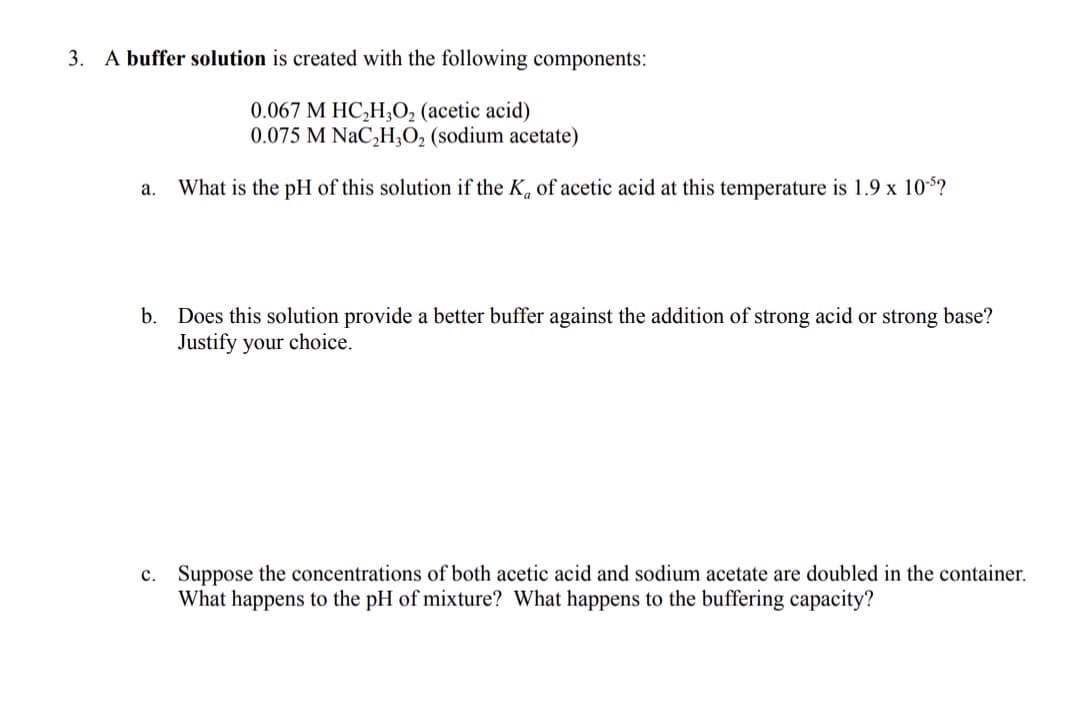3. A buffer solution is created with the following components: 0.067 M HC,H;O, (acetic acid) 0.075 M NaC,H,O, (sodium acetate) What is the pH of this solution if the K, of acetic acid at this temperature is 1.9 x 10$? a. b. Does this solution provide a better buffer against the addition of strong acid or strong base? Justify your choice. Suppose the concentrations of both acetic acid and sodium acetate are doubled in the container. What happens to the pH of mixture? What happens to the buffering capacity? с.
3. A buffer solution is created with the following components: 0.067 M HC,H;O, (acetic acid) 0.075 M NaC,H,O, (sodium acetate) What is the pH of this solution if the K, of acetic acid at this temperature is 1.9 x 10$? a. b. Does this solution provide a better buffer against the addition of strong acid or strong base? Justify your choice. Suppose the concentrations of both acetic acid and sodium acetate are doubled in the container. What happens to the pH of mixture? What happens to the buffering capacity? с.
Chemistry & Chemical Reactivity
10th Edition
ISBN:9781337399074
Author:John C. Kotz, Paul M. Treichel, John Townsend, David Treichel
Publisher:John C. Kotz, Paul M. Treichel, John Townsend, David Treichel
Chapter17: Principles Of Chemical Reactivity: Other Aspects Of Aqueous Equilibria
Section: Chapter Questions
Problem 89GQ: A buffer solution is prepared by dissolving 1.50 g each of benzoic acid, C6H5CO2H, and sodium...
Related questions
Question
Can you help me with this?

Transcribed Image Text:3. A buffer solution is created with the following components:
0.067 M HC,H3O, (acetic acid)
0.075 M NaC,H;O, (sodium acetate)
What is the pH of this solution if the K, of acetic acid at this temperature is 1.9 x 10$?
а.
b. Does this solution provide a better buffer against the addition of strong acid or strong base?
Justify your choice.
c. Suppose the concentrations of both acetic acid and sodium acetate are doubled in the container.
What happens to the pH of mixture? What happens to the buffering capacity?
Expert Solution
This question has been solved!
Explore an expertly crafted, step-by-step solution for a thorough understanding of key concepts.
This is a popular solution!
Trending now
This is a popular solution!
Step by step
Solved in 3 steps with 2 images

Knowledge Booster
Learn more about
Need a deep-dive on the concept behind this application? Look no further. Learn more about this topic, chemistry and related others by exploring similar questions and additional content below.Recommended textbooks for you

Chemistry & Chemical Reactivity
Chemistry
ISBN:
9781337399074
Author:
John C. Kotz, Paul M. Treichel, John Townsend, David Treichel
Publisher:
Cengage Learning

Chemistry & Chemical Reactivity
Chemistry
ISBN:
9781133949640
Author:
John C. Kotz, Paul M. Treichel, John Townsend, David Treichel
Publisher:
Cengage Learning

General Chemistry - Standalone book (MindTap Cour…
Chemistry
ISBN:
9781305580343
Author:
Steven D. Gammon, Ebbing, Darrell Ebbing, Steven D., Darrell; Gammon, Darrell Ebbing; Steven D. Gammon, Darrell D.; Gammon, Ebbing; Steven D. Gammon; Darrell
Publisher:
Cengage Learning

Chemistry & Chemical Reactivity
Chemistry
ISBN:
9781337399074
Author:
John C. Kotz, Paul M. Treichel, John Townsend, David Treichel
Publisher:
Cengage Learning

Chemistry & Chemical Reactivity
Chemistry
ISBN:
9781133949640
Author:
John C. Kotz, Paul M. Treichel, John Townsend, David Treichel
Publisher:
Cengage Learning

General Chemistry - Standalone book (MindTap Cour…
Chemistry
ISBN:
9781305580343
Author:
Steven D. Gammon, Ebbing, Darrell Ebbing, Steven D., Darrell; Gammon, Darrell Ebbing; Steven D. Gammon, Darrell D.; Gammon, Ebbing; Steven D. Gammon; Darrell
Publisher:
Cengage Learning

Chemistry: An Atoms First Approach
Chemistry
ISBN:
9781305079243
Author:
Steven S. Zumdahl, Susan A. Zumdahl
Publisher:
Cengage Learning

Chemistry
Chemistry
ISBN:
9781305957404
Author:
Steven S. Zumdahl, Susan A. Zumdahl, Donald J. DeCoste
Publisher:
Cengage Learning
